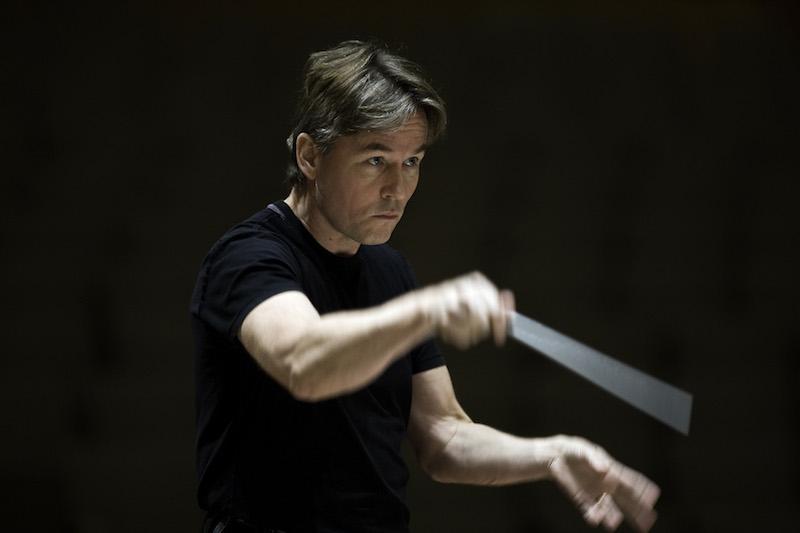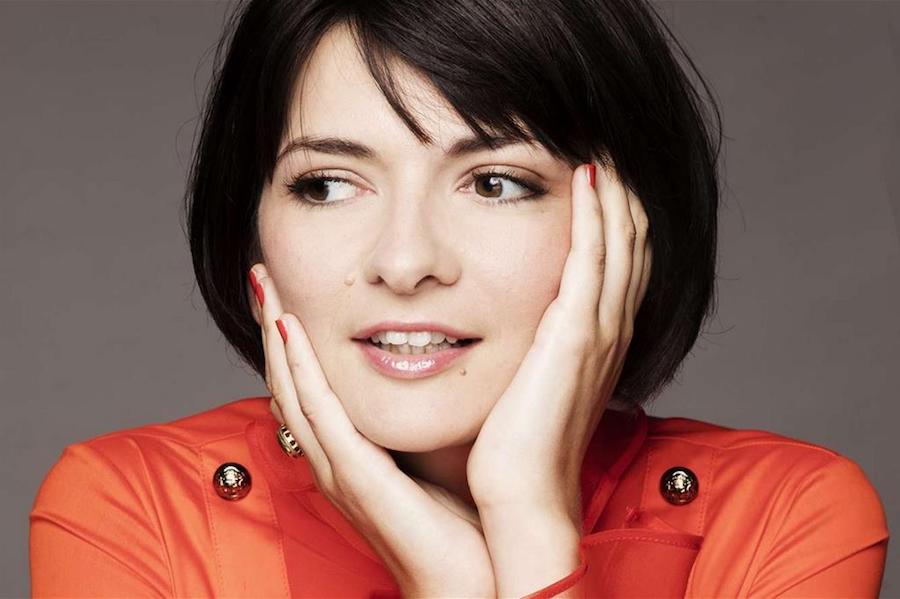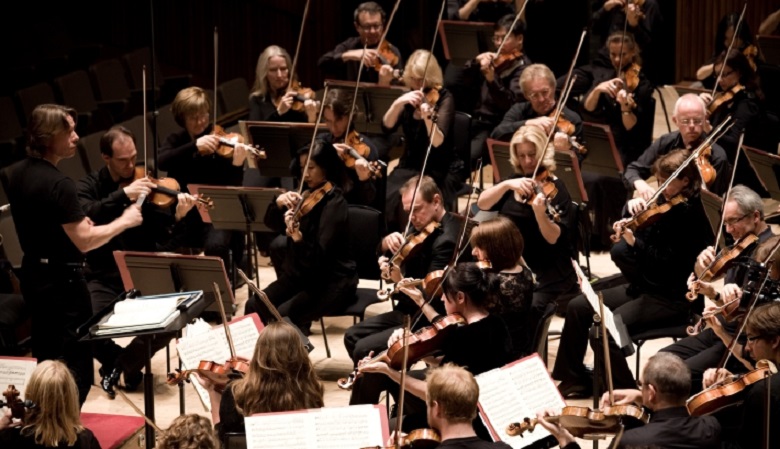Prom 24 review: Crebassa, Philharmonia, Salonen – thrilling performance of Adams masterpiece | reviews, news & interviews
Prom 24 review: Crebassa, Philharmonia, Salonen – thrilling performance of Adams masterpiece
Prom 24 review: Crebassa, Philharmonia, Salonen – thrilling performance of Adams masterpiece
Conductor and performers raise the roof but deserve a bigger audience

The title of John Adams’s Naive and Sentimental Music is a bit of a tease. Read literally it promises – or threatens – unsophisticated mawkishness, though that is the last thing it delivers. But maybe it was this title, alongside relatively unfamiliar 20th century repertoire, that kept the audience away.
The Philharmonia Orchestra under Esa-Pekka Salonen began with a musical palate-cleanser, the rarely heard Stravinsky arrangement of Bach’s Canonic Variations on “Vom Himmel Hoch”. Stravinsky goes beyond the normal ambit of the arranger in transforming Bach’s organ variations, re-arranging the order of the movement, transposing some, adding choir and even superimposing his own melodic lines and harmony notes.
The result, like Pulcinella over 30 years earlier, is delicious, if more sober and respectful towards its source. The soundworld is pure Agon, the ballet Stravinsky was composing at the same time. Salonen rightly kept the textures transparent and the tempos on the fast side, without compromising the detail of the polyphony. Both the brass section and principal flute Samuel Coles shone, as they did all night.
 Ravel’s Shéhérazade is a set of three songs with orchestra, sung here by French mezzo-soprano Marianne Crebassa (pictured above). Although unrelated to his earlier planned opera on the Arabian Nights, the operatic impulse remains evident. From the opening words – “O Asia, magic land of nursery tales” – we are far removed from Bach’s sombre Protestant Germany.
Ravel’s Shéhérazade is a set of three songs with orchestra, sung here by French mezzo-soprano Marianne Crebassa (pictured above). Although unrelated to his earlier planned opera on the Arabian Nights, the operatic impulse remains evident. From the opening words – “O Asia, magic land of nursery tales” – we are far removed from Bach’s sombre Protestant Germany.
Being Ravel, of course, the orchestration is rich and sensuous, conjuring up an exotic, imaginary, Arabia. But there were also some wonderful colours in Marianne Crebassa’s vividly characterised singing. She was extrovert and engaging but not meretricious, and responded sensitively to the orchestra behind her, especially in the second song, “The Enchanted Flute” – another starring moment for the ubiquitous Samuel Coles.
John Adams’s Naive and Sentimental Music was commissioned by Esa-Pekka Salonen for the Los Angeles Philharmonic in 1999, and it is clearly an important piece for him. It is a 50-minute work in three substantial movements, inspired, according to the composer, by the spacious spans and long crescendos of Bruckner’s Fourth Symphony. Adams shows masterful control of his large-scale structures, and uses his instrumental resources brilliantly in this effective concerto for orchestra.
The title comes from Friedrich Schiller’s 1795 essay Über naive und sentimentalishe Dichtung, which contrasts poetry that exists on its own terms with that which engages with the world and other works of art. This perhaps reflects Adams’s own progression from minimalist abstraction to operas that are firmly located within the modern world.
Certainly, Naive and Sentimental Music is a world away from his minimalist roots in Shaker Loops and Harmonium. Rather than the repetitive processes of Reich and Glass, Adams uses symphonic argument in a way that Sibelius or Mahler would have understood, and the first two movements emerge out of ever-evolving melody, with scarcely any repetition. Pacing is everything in this piece, and Adams and Salonen between them got things spot on, building inexorably from gentle beginnings to pounding climaxes.
 The end of the first movement, which started with solo flute (again) and pulsing harp, was driven forward by Salonen into a heady orchestral melee, owing something to the “Danse sacrale” from the Rite of Spring. It was exhilarating, a kaleidoscope of clangorous percussion and flaring brass, proudly maximalist music, and breathtaking in the hall.
The end of the first movement, which started with solo flute (again) and pulsing harp, was driven forward by Salonen into a heady orchestral melee, owing something to the “Danse sacrale” from the Rite of Spring. It was exhilarating, a kaleidoscope of clangorous percussion and flaring brass, proudly maximalist music, and breathtaking in the hall.
Salonen was as persuasive in the icy calm of the second movement, with its gentle electric guitar and eerie bowed percussion, as in the frenzy of the first. He is a superb conductor, willing to take centre stage but never imposing himself over and above the music. The Philharmonia (pictured above) responded with scintillating playing, whether letting rip or floating in hushed whisper.
Where the first two movements are conceived melodically, the final one has almost no tunes, depending instead on rhythmic cells which emerge, grow, take over, and are then superseded in their turn. The last movement has nods to minimalism, such as in the chattering bass clarinet evoking Reich’s Music for 18 Musicians, but as it flies headlong to its ending this showpiece is no one but John Adams. This terrific performance deserved its standing ovation, but it’s a pity there weren’t more people there to join it.
rating
Share this article
Add comment
The future of Arts Journalism
You can stop theartsdesk.com closing!
We urgently need financing to survive. Our fundraising drive has thus far raised £49,000 but we need to reach £100,000 or we will be forced to close. Please contribute here: https://gofund.me/c3f6033d
And if you can forward this information to anyone who might assist, we’d be grateful.

Subscribe to theartsdesk.com
Thank you for continuing to read our work on theartsdesk.com. For unlimited access to every article in its entirety, including our archive of more than 15,000 pieces, we're asking for £5 per month or £40 per year. We feel it's a very good deal, and hope you do too.
To take a subscription now simply click here.
And if you're looking for that extra gift for a friend or family member, why not treat them to a theartsdesk.com gift subscription?
more Classical music
 From Historical to Hip-Hop, Classically Black Music Festival, Kings Place review - a cluster of impressive stars for the future
From quasi-Mozartian elegance to the gritty humour of a kitchen inspection
From Historical to Hip-Hop, Classically Black Music Festival, Kings Place review - a cluster of impressive stars for the future
From quasi-Mozartian elegance to the gritty humour of a kitchen inspection
 Shibe, LSO, Adès, Barbican review - gaudy and glorious new music alongside serene Sibelius
Adès’s passion makes persuasive case for the music he loves, both new and old
Shibe, LSO, Adès, Barbican review - gaudy and glorious new music alongside serene Sibelius
Adès’s passion makes persuasive case for the music he loves, both new and old
 Anja Mittermüller, Richard Fu, Wigmore Hall review - a glorious hall debut
The Austrian mezzo shines - at the age of 22
Anja Mittermüller, Richard Fu, Wigmore Hall review - a glorious hall debut
The Austrian mezzo shines - at the age of 22
 First Person: clarinettist Oliver Pashley on the new horizons of The Hermes Experiment's latest album
Compositions by members of this unusual quartet feature for the first time
First Person: clarinettist Oliver Pashley on the new horizons of The Hermes Experiment's latest album
Compositions by members of this unusual quartet feature for the first time
 Gesualdo Passione, Les Arts Florissants, Amala Dior Company, Barbican review - inspired collaboration excavates the music's humanity
At times it was like watching an anarchic religious procession
Gesualdo Passione, Les Arts Florissants, Amala Dior Company, Barbican review - inspired collaboration excavates the music's humanity
At times it was like watching an anarchic religious procession
 Classical CDs: Camels, concrete and cabaret
An influential American composer's 90th birthday box, plus British piano concertos and a father-and-son duo
Classical CDs: Camels, concrete and cabaret
An influential American composer's 90th birthday box, plus British piano concertos and a father-and-son duo
 Cockerham, Manchester Camerata, Sheen, Martin Harris Centre, Manchester review - re-enacting the dawn of modernism
Two UK premieres added to three miniatures from a seminal event of January 1914
Cockerham, Manchester Camerata, Sheen, Martin Harris Centre, Manchester review - re-enacting the dawn of modernism
Two UK premieres added to three miniatures from a seminal event of January 1914
 Kempf, Brno Philharmonic, Davies, Bridgewater Hall, Manchester review - European tradition meets American jazz
Bouncing Czechs enjoy their Gershwin and Brubeck alongside Janáček and Dvořák
Kempf, Brno Philharmonic, Davies, Bridgewater Hall, Manchester review - European tradition meets American jazz
Bouncing Czechs enjoy their Gershwin and Brubeck alongside Janáček and Dvořák
 Solomon, OAE, Butt, QEH review - daft Biblical whitewashing with great choruses
Even a top soprano and mezzo can’t make this Handel paean wholly convincing
Solomon, OAE, Butt, QEH review - daft Biblical whitewashing with great choruses
Even a top soprano and mezzo can’t make this Handel paean wholly convincing
 Two-Piano Gala, Kings Place review - shining constellations
London Piano Festival curators and illustrious friends entertain and enlighten
Two-Piano Gala, Kings Place review - shining constellations
London Piano Festival curators and illustrious friends entertain and enlighten
 Echo Vocal Ensemble, Latto, Union Chapel review - eclectic choral programme garlanded with dance
Beautiful singing at the heart of an imaginative and stylistically varied concert
Echo Vocal Ensemble, Latto, Union Chapel review - eclectic choral programme garlanded with dance
Beautiful singing at the heart of an imaginative and stylistically varied concert
 Scott, Irish Baroque Orchestra, Whelan, RIAM, Dublin review - towards a Mozart masterpiece
Characteristic joy and enlightenment from this team, but a valveless horn brings problems
Scott, Irish Baroque Orchestra, Whelan, RIAM, Dublin review - towards a Mozart masterpiece
Characteristic joy and enlightenment from this team, but a valveless horn brings problems

Comments
I was amazed to be offered a